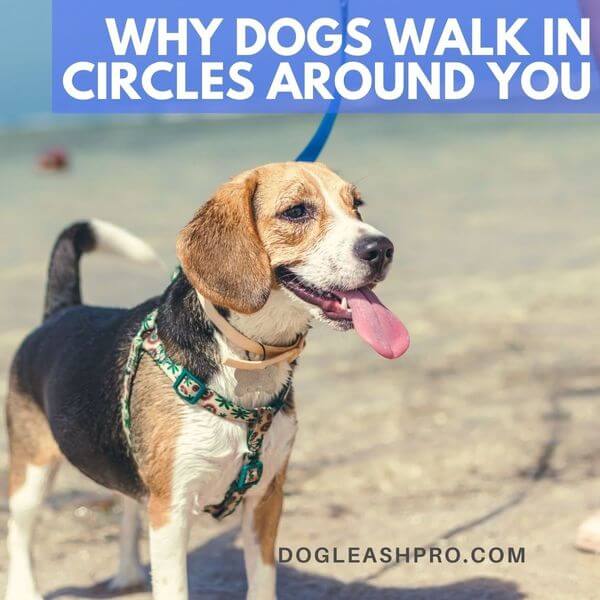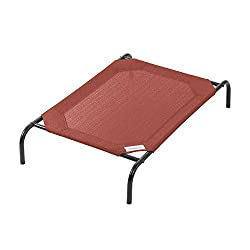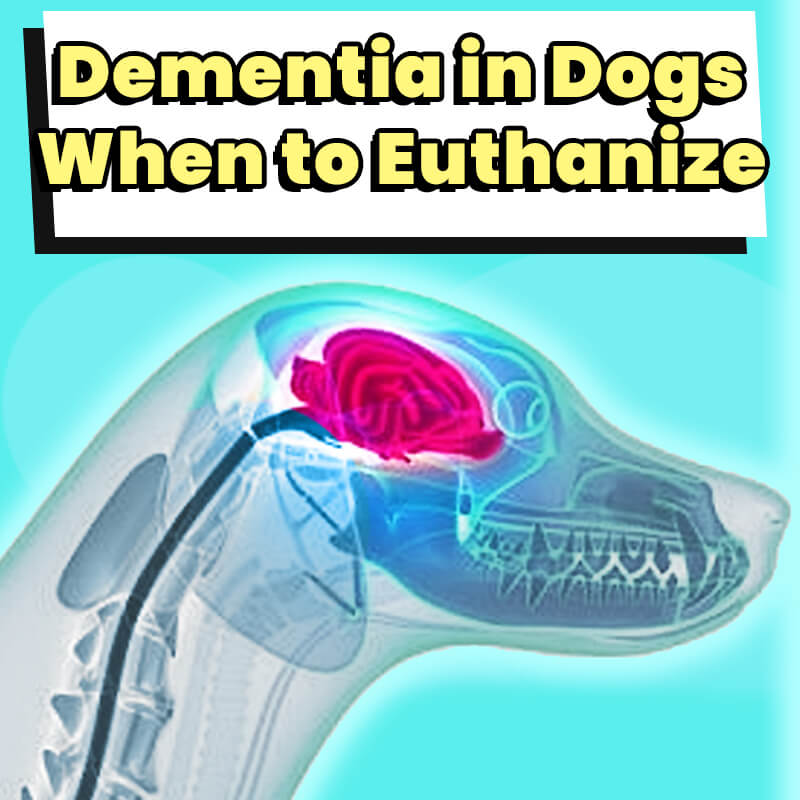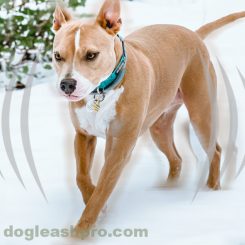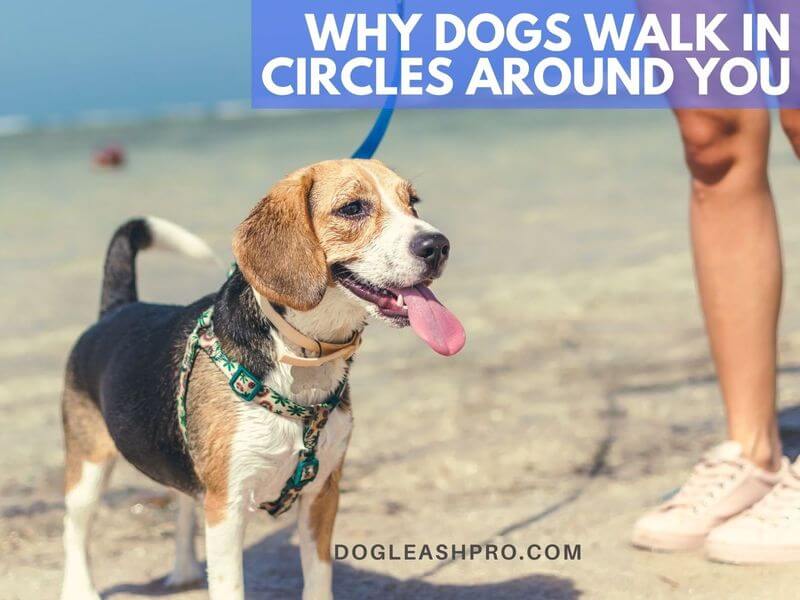
Dogs can’t talk, but that doesn’t mean you can’t understand them. Dogs can communicate a lot through their actions. But many pet owners don’t know what these gestures or actions mean. Circling is one such activity that can be pretty confusing for owners.
Why does my dog walk in circles around me? The exact reason for this behavior depends on the dog’s breed, age, and health. It can signify excitement, pleasure, anxiety, or fear. Or it may also be a sign of medical issues or even disease.
While the reason behind your dog’s circling habit can be annoying or even trivial to some, maybe it’s time you look into what’s causing it as this behavior may signal some health issues. Let’s explore deeper in this article.
Table of Contents
What is circling?

Circling is when your dog seems to spin in orbit. They may do it around you, another animal, or an object. Most times, this behavior is perfectly normal. However, it’s best to watch out for anything out of the ordinary, as circling can also be a sign of sickness or injury.
Where do dogs learn to circle?
Dogs don’t always pick up the circling habit; many are born with it. They’ve kept this practice from their feral ancestors. Even after generations of domestication, this habit still appears in pet dogs.
During their days in the wild, dogs used circling to trap and hunt their prey. Humans have used this habit of dogs to round up livestock for centuries.
You can see that this behavior has deep roots. Apparently, you can take the dog out of the wilderness, but you can’t take the wilderness out of the dog!
What makes dogs circle around their owners?
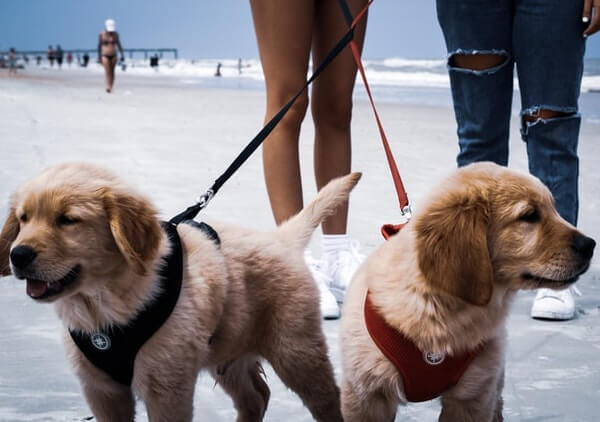
Now you know what circling is and where dogs learn it, let’s explore some common reasons behind it.
1. Excitement
Most dogs show their excitement by running around in circles. They’ll run around you if you are the reason for their excitement.
If you’re holding a treat, toy, leash, or anything your dog enjoys, they will get excited in anticipation. If another person or animal is the source of their excitement, the dog will circle them.
2. Happiness
Happiness is another emotion that makes the dog run in circles. Similar to excitement, the anticipation of fun activities makes the dog happy, and they will probably show it by running in circles around you.
Many owners experience this when they enter their homes after a long absence. If your dog does this, it’s just because they’re happy to see you.
3. Fear or anxiety
In the wild, members of the pack look to their leader for protection. Domesticated dogs see their owners the same way. If something is making our dog nervous, they will try to move close to us, hoping to feel safe.
Circling is a way for anxious dogs to find safety in our shelter. If the dog appears afraid while circling you, be gentle and try to calm him down.
4. Unease
Physical or mental unease may also trigger circling in dogs. As mentioned above, dogs look to their owners for protection.
If your dog is hurt or in pain, they will try to get your attention by circling you. If your dog isn’t the circling type, look for signs of injury, discomfort, or stiffness. Consult a vet if anything seems out of the ordinary.
5. Dog’s breed
For many centuries, humans have used certain dog breeds for herding livestocks. Such dogs have the circling habit stored in their DNA.
If your dog belongs to a herding variety, you’d often notice them circling you, your family, or other animals. They’re unknowingly trying to round you up as part of their genetic training.
Dog breeds that commonly display this behavior include:
- Collies – like Bearded, Smooth, Rough, Scotch, and Border Collies.
- Shepherds – like German, Caucasian, Australian, Belgian, and English Shepherds.
- Sheepdogs – like Polish, Old-English, Bergamasco, Icelandic, and Gaucho Sheepdogs.
- Welsh Corgi – like the Cardigan and Pembroke Welsh Corgi.
- Other herding breeds include Lapphund, Briard, Beauceron, and Cattle dogs.
RECOMMENDED: Golden Collie (Complete Guide)
Why do dogs circle before they lay down?

You may notice your dog spinning around a few times before lying down. This is another evolutionary trait left in dogs by their wild ancestors. Back when dogs used to live out in the open, circling before going to bed was a safety routine.
So how can circling make the dogs feel safe?
Feral canines sleep with their noses to the wind. This way, their noses can act as an early warning system if someone unwanted tries to approach them while they sleep.
Spinning a few times gives dogs a sense of wind direction and the optimal position to settle down. Although pet dogs live in the safety of their owner’s homes, this habit hasn’t gone away.
While pet dogs sleep in clean beds, wild canines make their beds out of bushes, vegetation, dirt, and twigs.
Circling a few times on their “bed” pats it down and makes it more comfortable. It also forces out any critters that might’ve taken shelter in there.
Dogs also circle before sleeping to get an idea of their surroundings. By spinning a few times, they can gauge the area and where potential attacks may come from.
Our dogs’ ancestors were pack animals, and circling before sleeping helped them glance at their family to ensure everything is fine.
No matter how safe we make things for our canine buddy, our dog wouldn’t let go of his survival instincts.
Owners shouldn’t worry if their pooch performs this safety ritual before bed. Your dog isn’t feeling unsafe; it’s just holding on to tradition.
However, if the dog circles for too long before lying down and appears to be in pain, it may be suffering from orthopedic issues.
Arthritis, backbone problems, or injuries may cause severe discomfort, and the process of lying down can be agonizing.
We recommend this elevated dog bed if your dog is suffering from orthopedic issues.
5 Behavioral issues that cause circling

A dog’s circling habit can be a behavioral matter. If you’ve ensured your dog is otherwise healthy, proper training can make the habit go away. Here are five common behavioral issues that trigger circling in dogs.
1. Temperament
Some dogs, typically males, are instinctively dominant. By spinning around a human or another animal, they’re trying to assert their stature. If the dog is forcing you to move when he circles, he’s likely trying to establish himself as the alpha.
2. Pent-up energy
Young and energetic dogs love moving around. They’re filled to the brim with energy, and they need to let it out. If your dog doesn’t get enough exercise and lives cooped up in a small space, running in circles might be their way of getting rid of all that unused energy.
3. Encouragement
Some owners see circling as adorable and may knowingly or unknowingly encourage this behavior in their dogs. The dog considers this activity rewarding and may adopt it as a habit.
4. Emotional trauma
Dogs with past emotional traumas may be shy and uneasy in an unfamiliar environment. Circling their owner is them trying to look for emotional shelter.
5. Ancestral instincts
Dogs that belong to herding breeds instinctively circle humans and other animals. This comes from ancestors who were used for herding livestock for generations. If your dog is from a family of herders, their circling habit is natural and can go away with training.
7 Medical Conditions that cause circling
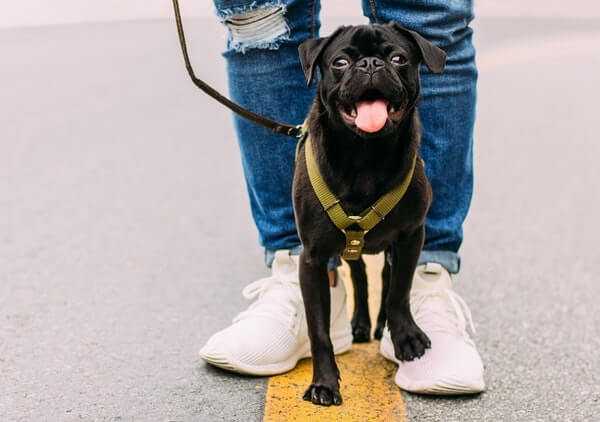
Some medical conditions may cause old or sick dogs to move in circles uncontrollably. It’s best to catch these issues in time to prevent things from getting worse. Medical disorders which may compel dogs to circle include:
1. Dementia
Dementia or Alzheimer’s disease rarely affects young dogs and is more common among senior canines.
The affected dog may randomly space out and seem confused. As the disease progresses, they slowly lose their sense of direction and cognitive functions.
Circling is a symptom of dog dementia and it may be hard to notice at first—as the dog may be doing it slowly.
But once the condition worsens, the dog seems to spin more noticeably. Sadly, there is no cure for this disease, and the situation only gets worse with time.
2. Ear infection
Infections in the dog’s ear can sometimes spread to their inner ear, reaching their vestibular system. The inner ear contains the mechanism responsible for maintaining balance.
Any disturbance in that system—such as an infection—can make the dog’s sense of balance go haywire, causing them to circle uncontrollably.
Inner-ear infection requires immediate medical care and is usually easily treatable. Other than circling, signs of inner-ear infection include redness, soreness, scabs, and foul smell.
3. Vestibular syndrome
Vestibular syndrome is another inner ear disorder that can mess with a dog’s equilibrium.
Commonly found in elderly canines, vestibular syndrome symptoms include moving in circles, knocking into objects, drooling, and collapsing randomly.
While the exact culprit is unknown, vestibular diseases can be brought on by old age, injury, nutritional deficiency, inner ear infection, or abnormal tissue inflammation.
4. Concussion
A severe blow to the head can lead to a concussion. This can cause balance issues in dogs, making them dizzy and walk in circular patterns.
Concussions are serious injuries and need time to heal. After getting the dog proper treatment, allow them a few days to recuperate.
5. Parasites
Dogs may also move in circles if they have an irritated and inflamed rear end.
Parasites like lice, mites, and fleas near their tail area can cause itchiness and cause dogs to drag or scoot their behind against the floor.
The dog may constantly try to bite or lick their private area, and that may cause them to move in circles, chasing their behind.
Parasites can also cause Neosporosis. The disease affects the spatial awareness and coordination of the dog, making them walk in circles.
6. Liver disease
The prime job of the liver is to keep the body free from toxic waste. If some disease disrupts the normal liver function, the toxins build up.
One of these toxins is ammonia, the excess of which eventually reaches the brain and sends the entire nervous system into disarray.
The dog will show disorientation, causing them to run into objects and walk in circles. The treatment for liver disease requires hospitalization.
If your dog is circling abnormally, look for signs of liver disease, such as dizziness, lethargy, weakness, indigestion, and disorientation.
7. Arthritis
Arthritis or joint pain is another ailment that comes with old age. The affected pooch may have trouble bending its joints to sit. By circling, they try to find a comfortable position.
When your dog first started circling you
Circling isn’t exactly a sign of trouble if your dog belongs to a herding breed and has always done it. However, if your dog just picked up this habit, it’s best to rule out any possible medical problems.
Owners of senior dogs shouldn’t take it lightly if their dog shows circling behavior. Elderly dogs are more susceptible to degenerative health issues so if they show unusual behavior, it’s best to consult the vet right away.
It is also possible that the dog adopted this habit after encouragement. Circling may seem like an adorable trick, and you or someone in your family might be encouraging this behavior. If it troubles you, stop reinforcing it.
When and where your dog circles you most
You may notice your dog acting differently in certain situations and locations. As circling also signals stress, fear, and anxiety, look for surrounding elements that might be frightening your dog.
Herding instincts may subconsciously drive dogs to circle you and other people. When they see a group, they think of them as a herd and try to round them up. With a bit of training, dogs can stop doing that.
It’s challenging to walk with a dog orbiting you. You get all tied up in the leash, and a short walk becomes a chore. This typically happens if the dog is too excited or wants to explore its surroundings. Dogs give up this habit through training and proper control.
Why you might want to stop your dog from doing this
Circling may look cute to some, but not everyone would want their dog behaving that way. If the dog doesn’t have any medical issues, it can drop its circling habit with proper training.
If the dog is treating humans as a herd, this behavior can be dangerous. Herding dogs sometimes snap at ankles or act aggressively around people while trying to round them up.
You’d want to make sure your dog isn’t a threat to humans. Some dogs like to assert their dominance. If they’re trying to get you to move by circling, you need to make them realize who’s in charge.
7 Things dog owners can do when your dog circles you
1. Asking a vet
If you notice your dog circling, the first thing to do is rule out diseases, infections, and injuries.
A vet can best diagnose the reason behind your dog’s circling. If needed, they’ll also prescribe the required medicine, supplements, diet, or training to stop your dog from doing that.
If it has to do with your furry friend’s diet, try Ollie Fresh Dog Food. Made with real, fresh, healthy human-grade ingredients, every meal is tailored to your dog’s unique nutritional needs.
The personalized meal plan is based on your pup’s health, weight, age, and breed and it is delivered right to our doorstep.
2. Not giving it attention
If your dog notices you giving them attention every time they run in circles, they’ll do it more often. If you want to stop your dog from behaving that way, ignore their circling.
Experts suggest looking away, turning around, or walking out of the room. If the dog doesn’t see the technique working, they’ll stop doing it.
3. Avoiding reinforcement
Some owners or their family members encourage certain behaviors in dogs. If the dog sees spinning as rewarding, or something that makes their human happy, they’ll do it more often.
4. Creating a diversion
Another way to stop a circling dog is to distract them. You can do this by making some noise, giving them a toy, or telling them to sit. Doing that enough times can make the dog drop the habit altogether. You should also reward them with a treat if they stop.
5. Giving them space
Living in a cramped space can get frustrating for a dog. Unlike cats, dogs are active animals who love physical activity.
Circling is one way for dogs to use up their unspent energy in a small space. Give the dog plenty of room when you leave them unattended.
6. Exercising regularly
Dogs need to use up their energy quota. If they can’t do that, they’ll get hyperactive and pace around in circles. Regular exercise is a surefire way to use up all that excess energy and keep the dog calm.
Be sure to walk your pups regularly so they get their daily exercise, both physically and mentally.
When walking your furry friends, be sure to use either a retractable dog leash or a rope dog leash to keep them safe, give them room to explore their surroundings, and all the while still under your control.
7. Training programs
Training programs can help dogs drop bad habits, even if they’re ingrained in their DNA. Herding dogs will stop trying to round people up after you put them through an effective training program. Consult your vet or a local kennel club on how to do that.
Final Thoughts
While a dog that enjoys running in circles may not be a cause for concern, a responsible keeper should know what it can signify. If the spinning is getting out of control, seek veterinary advice to treat any possible medical disorders. If the dog is circling out of habit, give them proper training and exercise.
You can’t talk to your dog, but you can still understand what’s going on with them. All you need is a little knowledge and a keen eye.

With over five years of specialized experience as an animal writer, my expertise lies in dog nutrition, health, behavior, grooming, and training. I am dedicated to delivering helpful and informative content that caters to the well-being of our furry friends. My primary goal is to empower pet owners with knowledge and ensure our canine companions thrive in health and happiness. In my free time, I love volunteering at local dog rescue centers.
